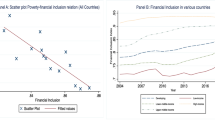Abstract
Contributing to the alleviation of poverty in recipient countries is one of the main goals of most aid organizations. In this paper the following question is asked: could it be the case that altruistic aid organizations are counter-productive in the sense that their activities may cause the extent of poverty to increase or the relative income distribution to worsen? The answer is yes and the reason is simply that recipient governments adjust in order to qualify for aid. It is shown that if recipient governments perceive themselves as being engaged in a competition for aid and/or if the aggregate aid budget is endogenous, then the incentive problems may become particularly severe.
Similar content being viewed by others
References
Boone, P. (1996). “Politics and the Effectiveness of Foreign Aid.” European Economic Review 40, 289–329.
Buchanan, J. (1975). “The Samaritan's Dilemma.” In E. Phelps (ed.), Altruism, Morality and Economic Theory. New York: Russel Sage Foundation.
Cassen, R. et al. (1994). Does Aid Work? Oxford: Clarendon Press.
Collier, P. (1997). “The Failure of Conditionality.” In C. Gwin and J. Nelson (eds.), Perspectives on Aid and Development. Washington: Overseas Development Counsil.
Dixit, A. and B. Nalebuff. (1991). Thinking Strategically. New York: W. W. Norton & Company.
Institute of Development Studies Bulletin. (1986). Special issue on Aid Effectiveness.
Journal of International Development. (1992). Special issue on Economic Analysis of Aid Policy.
Kemp, M. (1992). “The Static Welfare Effects of Foreign Aid.” In D. Savoie and I. Brecher (eds.), Equity and Efficiency in Economic Development. Montreal: McGill-Queens University Press.
Krueger, A., C. Michalopoulos, V. Ruttan (eds.). (1989). Aid and Development. Baltimore and London: John Hopkins University Press.
Lindbeck, A. and J. Weibull. (1988). “Altruism and Time Consistency: The Economics of Fait Accompli.” Journal of Political Economy 96(6), 1165–1182.
Maizels, A. and M. Nissanke. (1984). “Motivations for Aid to Developing Countries.” World Development 12, 879–900.
Pedersen, K. (1996). “Aid, Investment and Incentives.” Scandinavian Journal of Economics 98, 423–438.
Pedersen, K. (1997). “Incentives and Aid Dependence.” Mimeograph Series 1997/1. Expert Group on Development Issues. Stockholm: Swedish Ministry for Foreign Affairs.
Singer, H. (1965). “External Aid: For Plans or Projects?” Economic Journal 75, 539–545.
Squire, L. and H. van der Tak. (1976). Economic Analysis of Projects. Baltimore: John Hopkins University Press.
Trumball, W. and H. Wall. (1994). “Estimating Aid-Allocating Criteria with Panel Data.” Economic Journal 104, 876–882.
World Bank. (1998). Assessing Aid. Oxford: Oxford University Press.
Author information
Authors and Affiliations
Rights and permissions
About this article
Cite this article
Pedersen, K.R. The Samaritan's Dilemma and the Effectiveness of Development Aid. International Tax and Public Finance 8, 693–703 (2001). https://doi.org/10.1023/A:1012839126094
Issue Date:
DOI: https://doi.org/10.1023/A:1012839126094




